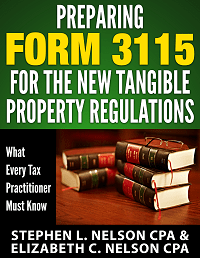2/17/2015 Update: Information about our e-book, which has been updated for Revenue Procedure 2015-20, appears at the bottom of page.
For 2014 and later years, the IRS regulations for differentiating between repairs expenditures (which you can immediately expense) and improvements (which you need to depreciate over a number of years) have changed.
Accordingly, if you own a small business or invest in real estate, you (or your bookkeeper) need to work to understand the new rules.
A Quick Catch-up
In a couple of other blog posts (see here and here) we talked about how these rules work in pretty general terms.
Basically, you need to treat an expenditure as an improvement if you “better” property, “restore” it, or “adapt it to a new or different use.”
Tip: If you want even more detail, refer to Treas. Reg. 1.263(a)-3(j), Treas. Reg. 1.263(a)-3(k) and Treas. Reg. 1.263(a)-3(l).
Why the Unit of Property Definition Matters
But here’s the next thing to note. How you define the property you’re talking about getting “bettered” or “restored” or “adapted” makes a difference.
For example, say you’ve got an apartment building. And say you renovate the air conditioning system. If you ask yourself, “Does renovating the air conditioning system better, restore, or adapt the apartment house?” you might easily answer “Well, no.”
In other words, if you’ve got an air conditioned apartment house, renovating the air conditioning might not, by strict definition, be an improvement to the whole building. It may be, for example, that while the renovations clearly extend the life of the air conditioning system, you could reasonably make the argument that the renovations don’t extend the life of the building as a whole. In fact, that argument used to work before the Treasury wrote these new rules.
Now, however, the rule says that if you pay for work performed on your air conditioning system and the amount paid “improves” the system, then you have to capitalize the amount paid for the air conditioning renovation as an improvement to the whole building.
Take a moment to read those last paragraphs carefully, because it’s a little bit nuanced. The “unit of property” improved is the whole building; it’s not just the air conditioning system. But what determines whether or not you have to capitalize isn’t whether an amount paid “betters,” “restores,” or “adapts” the building, but the air conditioner.
Note: The technical “unit of property” definition appears at Treas. Reg. § 1.263(a)-3(d).
So what does this mean for you practically? It means you often can’t deduct the cost of such renovations as repairs anymore. You need to capitalize the expenditures and depreciate them as improvements.
You can see how the definition you use matters, right? If a renovation is an improvement instead of a repair, you’ll generally only get to deduct on your tax return about 1/30th of the cost in the year you actually paid for the renovation.
OK, so now let’s look at these new rules in a little bit more detail…
Applying the Unit of Property Rules to Real Property
When applying the new improvement regulations to buildings, the tricky thing is, the new regulations break apart a building property into a building structure unit and building systems.
The building structure unit includes the actual building and its structural components.
The building systems units include the HVAC systems, the plumbing systems, electrical systems, escalators, elevators, fire-protection and alarm systems, security systems, gas distribution systems, and some other stuff we won’t get into here but which is also excepted from the building structure under the Treasury Regulation.
As we explained a bit above, if you make an improvement to a building system, you have to capitalize the amounts paid as an improvement to the whole building, since the building is considered the “unit of property.”
Applying the Unit of Property Rules to Personal Property
For property other than buildings, the rules work a little differently. With personal property, generally a “functional interdependence” rule applies.
Rather than try to paraphrase the Internal Revenue Service, let me just quote from Treas. Reg. 1.263-3(e)(3)(i) here: “Components of property are functionally interdependent if the placing in service of one component by the taxpayer is dependent on the placing in service of the other component by the taxpayer.”
This is pretty much an anti-abuse rule saying, “If you need all the parts of a machine together for the machine to work, then it’s one machine (and thus one ‘unit of property’). So no playing games with breaking apart the different pieces of the machine into different ‘assets.’”
By the way, there are special, more detailed regulations for plant property, network assets, and leased non-building property. I’m not going to try and summarize those here, however, because those regulations you may as well read yourself. Oh, and my condolences if you find yourself in this situation.
Quick Closing Comments
The practical reality is that whoever is making the general day-to-day journal entries needs to know these rules and make the accounting decision of capitalize versus expense when the asset is purchased or the work on the asset is paid for.
That probably means you want a written accounting policy that reflects the new rules—and that you want to try and faithfully use that policy. (We have a free, relatively short policy you can print and use at the blog post we referenced earlier.)
Furthermore, let’s be honest: The new rules are complicated. You can only do the best job you can. I think you try to comply as best you can—and hope if you’re ever audited the IRS agent gives you credit for your effort.
Need More Information about the New Regs?
With the issuance of Revenue Procedure 2015-20 (which appeared on February 13, 2015) most small businesses should not need to worry about the preparing Form 3115 for TRP-triggered accounting method changes. (See here for our post about the revenue procedure.)
However if you have taxpayers that need or want to follow the TPRs, you may interested in our ebook on the subject. Furthermore, most tax accountants will have at least a few clients who do need to file 3115 forms because if a taxpayer needs to report a late partial disposition, the absolution provided by Rev. Proc. 2015-20 doesn’t apply.
Accordingly, we’ve prepared a short, 60pp e-book. This downloadable e-book explains how the new regulations change the way small taxpayers need to do their accounting for tangible property deductions and then outlines a straight-forward approach to complying with new regulations.
Perhaps most useful, the e-book also provides three sample, completed 3115 forms for the most common accounting method change requests small taxpayers will need to make… and also a sample accounting policy which should help a small taxpayer stay in compliance in the future. For $100, you can purchase and immediately download this e-book. Click the button here to make your purchase:
Money Back Guarantee
And an important note: We’re providing a money-back guarantee… if you don’t find our e-book saves you several hours of time and lets you easily prepare 3115s (for which you should be able to charge some multiple of the price you pay for the book) just ask for a refund by sending us a short email.


I bought the Preparing Form 3115 book and I’m already using it. It’s great. My question is do buildings acquired before 2014 have to be separated into components now under the new regulations? Or can the taxpayer elect to apply the new regulations going forward to new buildings as they are purchased?
You don’t have to pseudo-cost-segregate old buildings… but you can retroactively apply the partial disposition rules to stuff that’s gone on in past… and you should apply these rules in future.
BTW, this partial disposition stuff (which really relates mostly to real estate investors) is not covered in any detail in the ebook. The ebook targets small business owners.
Bought book…nicely written in terms a “non reg” guy can understand…question on “Materials and Supplies” 3115…should there be a reference to use of the $500 de minimis safe harbor code section? Thanks.
An election isn’t an accounting method… and using an election or not using an election isn’t an accounting method. So, no, you shouldn’t need to file 3115 for TPR related elections. You do want to make the appropriate elections of course.
Do we need to purchase e book again to get the updated information?
No, you could have used the link I sent out last weekend. If you didn’t see that and downloaded your copy *before* last weekend, send me an email and I’ll reactivate your link.
BTW, Carmen? I’ve already sent you an email with a refreshed link you can use.
Hi Steve
Just re-read new De minimis safe harbor in T.D. 9636. Since it says taxpayer that elects De minimis may not “treat as a material or supply” what is paid for items that meet De minimis. Am I reading too literally; does this mean you should show the De minimus expenses as “other expenses” on a Schedule C and not as supplies?
Just noticed I posted previous comment under wrong topic; it is supposed to be under “Are you kidding me?”.
I think you are reading too literally… I think you show them as supplies.
Savvy blog post . I Appreciate the insight – Does anyone know if my business might be able to get access to a template a form copy to fill out ?
Our blog posts about the tangible property regulations (and there are more than half a dozen) provide quite a bit of detailed info about how to do the accounting for thet 3115. But, sorry, I think the only sample forms and templates appear in the e-book we sell $100. Sorry.
BTW, I don’t think the ebook makes sense for many do-it-yourself preparers… For what that’s worth…